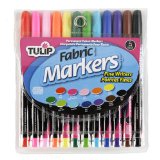Troubles with correcting a bleached spot
Name: Heather
—ADVERTISEMENTS—
The best answer for covering a bleach spot, after neutralizing the bleach, is to find a close color match in a fabric marker.

Tulip Fabric Markers
Fine Writers

Marvy Uchida Fabric Marker Brush Tip Set
assorted pastel colors
Country or region: Tennessee (U.S.)
Message: Hello,
I looked through your frequently asked questions but I couldn't find the exact answer I was looking for. I had a light pink button-up blouse that I absolutely loved, but one day I brushed up against a towel that my mother had dripped a cleaning solution on. It left two small bleach spots on the front, one the size of a dime and the other about the size of a nickel. The shirt is 100% cotton and only cost me around $15, but I really love the fit and it has a lot of sentimental value. I looked on your website and found a dyer who was willing to strip the color from the shirt and redye it back to light pink. Unfortunately, after I paid for it, the dyer returned the shirt to me in a horrible shade of hot pink (which does not look good at all with the light pink trim and buttons). To make matters worse, she obviously did not strip the color like she claimed she would because you can still see the faint spots. I am now trying to fix the shirt myself. I tried using Rit color remover on another shirt in the past with no success, so I'm hestitant to purchase more for this . I also tried linen bleach, thinking it would be a little gentler than regular bleach, but I'm not really sure I knew what I was doing. I used about two cups in a sink full of water and it didn't even turn the water pink. However, I didn't leave the shirt in the water very long so maybe that was the problem. Could you tell me how much bleach to use and how long I should leave it? Also, is linen bleach the same as regular bleach, like Clorox? Please help me! I know it sounds silly, but I'm just heartbroken over this shirt and I get teary-eyed every time I look at it or even think about never being able to wear it again. I really have my heart set on it being light pink and I've been trying to figure out how to do that since July. Any information you could give me would be appreciated. I'm desperate! Thank you for your time.
This is a sad situation. Bleach spots are very difficult to cover by dyeing, since dye is transparent and cannot completely cover a light spot in the same color as its darker surroundings. My usual suggestion is to find a close color match among the many different fabric markers sold at a good crafts or hobby store, and use it to color in the spot. See my page, "How can I fix the bleach spots on my favorite clothing?".
To remove dye, there are several available chemicals. See my page, "What chemicals can be used to remove dye?".
Sulfur-based Color Remover chemicals, such as Rit Color Remover (which is sodium dithionite) or Jacquard Color Remover (which is thiourea dioxide), work best at very high temperatures. You can try using either one in a cooking pot on your stovetop. This will work much better than using the color remover in a washing machine, since the water temperature never gets very hot in an American-made washing machine. (I always advise trying the washing machine method first anyway, since it's so much less trouble, but it sounds like you've gone beyond that with this shirt.) Rit Color Remover works extremely well on some dyes, and not nearly as well on others; it is impossible to know which dye you have until you try it. It's worth trying again with added heat, if you have not done so already, since it is much more effective that way. You should be able to find Rit Color Remover in your local fabric store, and very possibly also in a pharmacy or even at a big store like Walmart. Follow the instructions inside the box carefully!
Since bleach was able to make the spot to begin with, you might, very carefully, try using bleach to lighten the color of the blouse. While household chlorine bleach, which is based on the chemical sodium hypochlorite, can be damaging to fibers, especially synthetic fibers, it can be used on cotton if you are careful not to damage the fabric. Do not use bleach on the stovetop, since it becomes much more damaging when heated. Dilute the bleach with water in a bucket or washing machine, add the blouse, and stir it continuously (while wearing safety glasses, rubber gloves, and an apron, in case of splashes), until as much dye has been removed as it going to come out.
How much should you dilute the bleach? That depends entirely on the dye, so it's unpredictable. First try one cup of regular bleach per gallon of warm water, as recommended by The Clorox company's "Dr. Laundry" under "Lightening Blue Jeans". That is a 1:16 dilution. They say to leave it for 5 to 7 minutes, but you can allow up to 30 minutes, while watching closely for any color change, and stirring to prevent uneven bleaching. If that does not work, then you can try a stronger concentration, two cups or even four cups, but be careful to be ready to neutralize any remaining chlorine bleach immediately after washing out the blouse. Also note that the fumes from chlorine bleach are not at all healthy for your lungs, so it is best to do this out-of-doors. Rinse the bleach out thoroughly. To neutralize the bleach, use hydrogen peroxide or a thorough washing with a color-safe oxygen "bleach" such as OxyBoost; the peroxide produced by this sort of product will help to neutralize the continuing damage that can otherwise be done by the hypochlorite bleach. See my page, "How can I neutralize the damaging effects of chlorine bleach?".
It turns out that there is nothing special about Clorox Bleach Clean Linen, aside from (according to the MSDS) being a little more diluted with water, like other scented Clorox products. It is not specially effective for cleaning linen (which is a cellulose fiber, like cotton). What earns it the name of "clean linen" is merely the added fragrance, typically a cheap synthetic musk, which, to many people, after years of experiencing laundry detergents scented with cheap synthetic musk perfumes, has become synonymous with the scent of clean laundry. Personally, I prefer to get the plainest, least expensive hypochlorite-containing bleach, containing the fewest different ingredients, since I don't care for cheap perfumes. Unscented bleach has the added convenience of being usable for disinfecting water at home, in the event of a local natural disaster that contaminates the water supply, something that happens whenever water treatment plants lost power; scented bleach is not recommended for this purpose, but it's not as though you can just run out to the store and buy a new bottle of bleach under these circumstances. It's handier to make sure that you have some on hand among your laundry supplies.
If nothing else works for correcting the spot on your blouse, you will need to come to terms with owning it in a new color, whether the brighter pink or something else altogether. If you use the very easy-to-do technique of low water immersion dyeing (LWI), the resulting mottled pattern will work well for covering up the spot. So will tie-dyeing, for a different look. It won't be the same, but it might be better.
(Please help support this web site. Thank you.)
(Please help support this web site. Thank you.)
Posted: Tuesday - September 20, 2011 at 08:37 AM
Follow this blog on twitter here.
Quick Links
- All About Dyes & Dyeing Top -
- Top of this blog -
- FAQ -
- The Dye Forum -
- How to Tie Dye - How to Batik -
- Books - Toys - Plants -
- Top of this blog -
- FAQ -
- The Dye Forum -
- How to Tie Dye - How to Batik -
- Books - Toys - Plants -
More in this category:
- -
Statistics
Total entries in this blog:
Total entries in this category:
Published On: Aug 29, 2012 02:49 PM
Total entries in this category:
Published On: Aug 29, 2012 02:49 PM